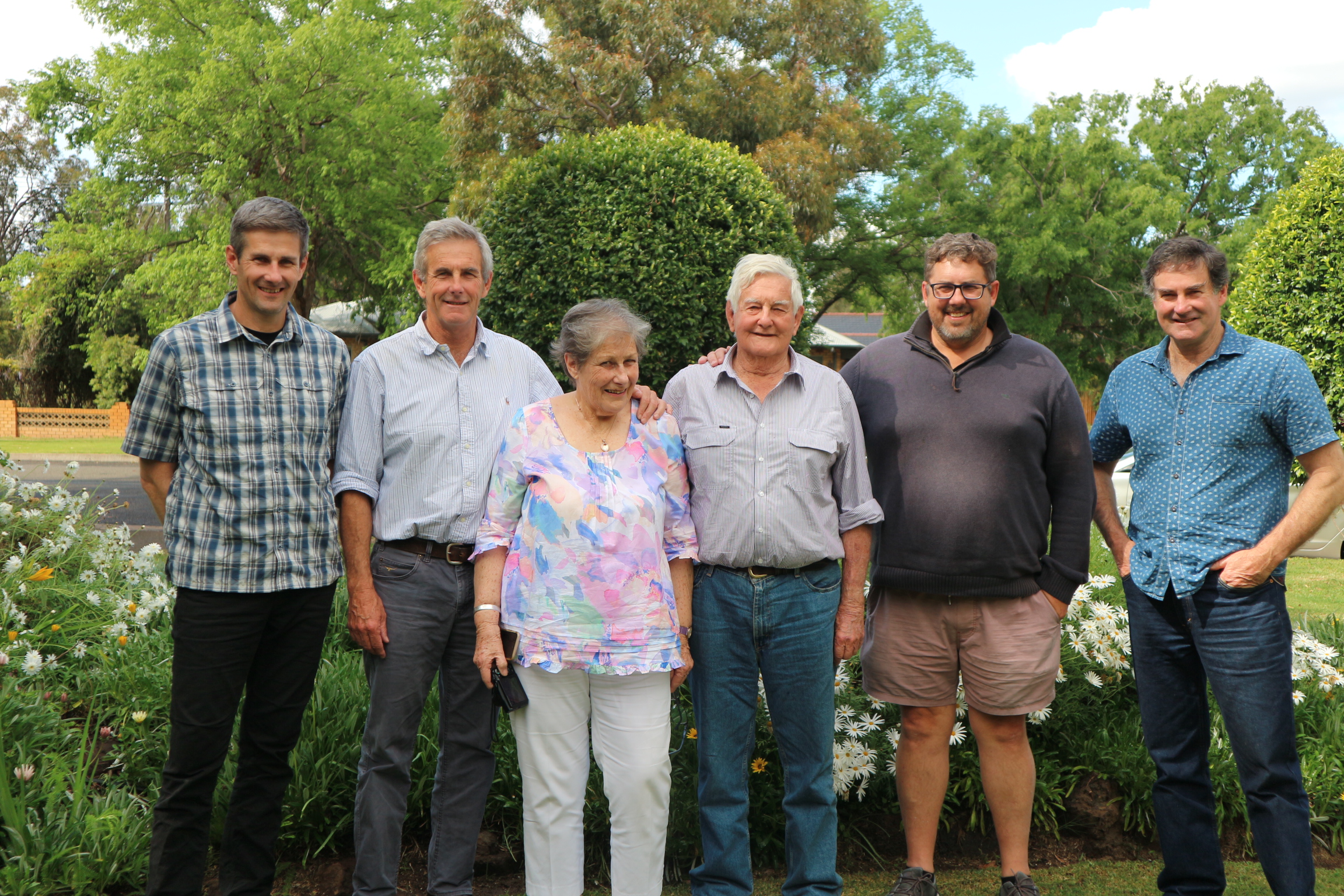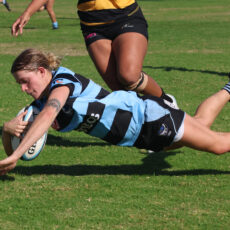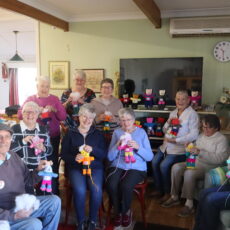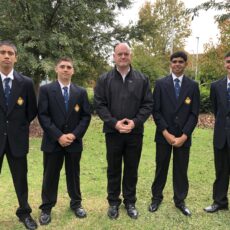John Porter Grellman – April 11, 1934-December 5, 2023
On Tuesday, December 5, 2023, John Porter Grellman, husband of Jenny, father of Timothy, David, Ian and Benjamin, passed away aged 89 years. An historical account of his life story, originally written by John, has been edited and abridged by David and Sharon Grellman.
John Grellman was born in West Wyalong on April 11,1934, the youngest son of Rupert and Phyllis Grellman, a brother for Marie (dec) and Jim (dec).
John was five when World War II broke out, and he remembered the community was busy helping with the war effort.
Helping others was a lifelong passion of John’s.
John recalled an idyllic childhood, with no restrictions or threats from outside, unlike today’s society.
He and his brother Jim would frequent the old gold diggings, robbing bottle swallow nests down the old mineshafts.
John thought one of their best undertakings was to make canoes out of sheets of corrugated iron and the youngsters would seal the holes and ends with melted tar from the roads.
These canoes were used to navigate the local bowling club dam situated at the end of the street, and they would fish for crayfish from the canoes.
As a young man, John played rugby league, swam and enjoyed the great outdoors.
John recalled swinging on a clothesline his father had made, well before the production of Hills Hoist, and it was so strong that John could swing on it without doing any damage to it at all.
The family stayed in West Wyalong for a few years after this and John recalled many fond memories of spending time on the farms near Burcher with his Porter cousins.
These were good times, with all the transport on the properties by sulky and the children would lay strychnine baits and traps for foxes or chase flyblown sheep. In later years, when he was around seventeen, John would work on ‘Clairinch’ (his uncle’s farm) during harvest, and at other times when the farm was busy.
As he grew older, John would help more and more with harvesting and shearing.
John went to school at the West Wyalong Public School until third year, when he headed off to The King’s School at Parramatta.
He considered himself an average scholar, but he was a swimming champion and played in the lower grades of rugby and cricket.

John left school in 1950 and joined the National Bank at West Wyalong. Whilst working there he represented the bank in the national inter-bank swimming championships held at North Sydney.
When John left school in 1950, he joined the National Bank at West Wyalong.
Whilst working there, he represented the bank in the National Inter-bank swimming championships held in North Sydney, where he came third.
Following a transfer to the Manly branch in 1952, John joined the Manly Surf Club.
Whilst at Manly, John was called up to National Service and served in the RAAF Air Sea Rescue unit at Rathmines, Lake Macquarie.
He played rugby with Nobbies, and the team ended up winning a premiership.
After national service, the National Bank transferred John to Orange, and later Wollongong.
However, John decided the banking industry was not the life he wanted and made the decision to join his brother Jim at Wagga Agricultural College.
It was 1954, and this was the decision that mapped out John’s path and the way he would spend the rest of his working life.
John said the three years spent at Wagga Agricultural College were some of the best years he had experienced.
The friendships he made there remained strong and even after 60 years, the surviving college friends still would meet for a biennial reunion.
Whilst studying at college, John had the good fortune to play in both the 1st XV rugby team and XI cricket for three years, as well as winning the swimming championships each year and playing in basketball and tennis teams.
John also won the college Hawkesbury Cup in his final year which was awarded for achievements in sport, academics and citizenship.
During his time at college John spent every holiday working, usually on an uncle’s farm.
This helped with the fees and gave some degree of independence. John next received a scholarship to study Rural Science at UNE.
However, after six months into the course, John realised that starting a four-to-six-year university course was not the best plan for his life.
It was now that John embarked on an amazing and varied journey in many aspects of the rural industries of Australia.
After working as an expert in a shearing team in the Hay plains, he took a big step and moved to New Britain in New Guinea to work on a plantation that grew copra, cocoa and palm oil.
The plantation was situated on an old Japanese military base and featured tunnels with rail tracks throughout.
There was even an underground hospital and many trenches scattered all around the plantation.
When John was there, it was only around 12 years after the war had ended, so there was much evidence of Japanese occupation.
After nearly a year of immersing himself in New Guinean life, learning the local languages and having many different experiences, John contracted dengue fever and returned to Australia.
Upon returning home, John firstly joined Elders as a stock salesman at Dubbo, next joining the Department of Agriculture as a sheep livestock officer. John’s first posting in this role was to the Cowra Research Station, and he was not there very long before being transferred to the Leeton Research Station.
Being transferred to Leeton was, possibly, the luckiest move John made, for it was there that he met Jenny Luelf, his future bride, playing in a local tennis competition.
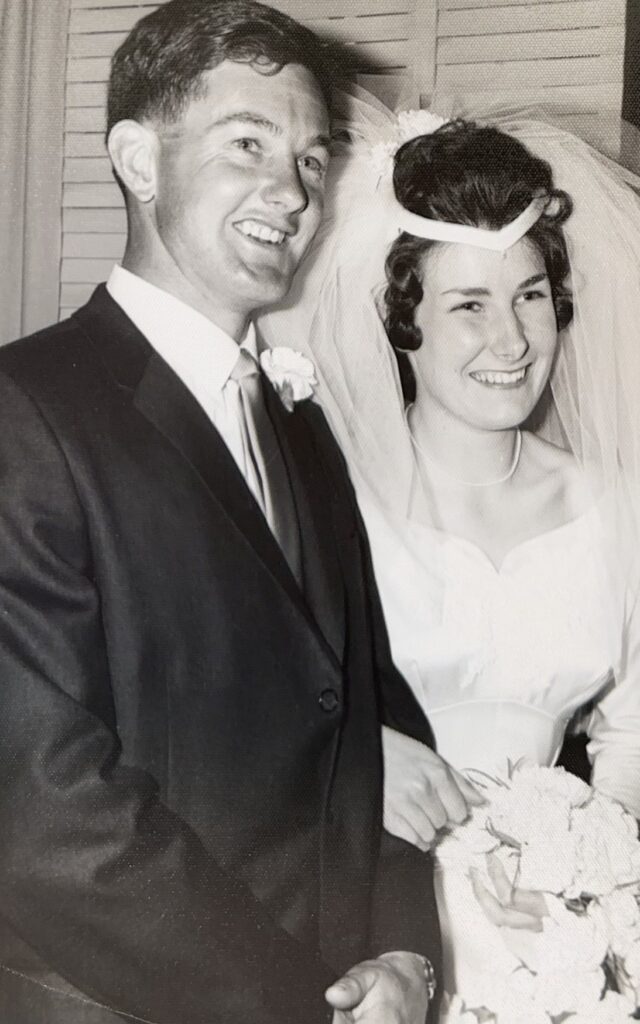
John and Jenny Grellman on their wedding day in Leeton on October 6, 1962.
John and Jenny celebrated their wedding in Leeton on October 6, 1962 and were together for more than 60 joyous years.
During the next 20 years or so, the couple moved many, many times and their family expanded to include four sons: Timothy born in 1963, David 1964, Ian 1970, and Benjamin in 1974.
Family life started out at a property near Forbes called ‘Jemalong’, and together with stock on the farm, this would be John’s first experience in growing cotton, in those days it was baled and sent off to Brisbane.
Later, from a 70-square house at ‘Mulgutherie west of Forbes’ they moved into a 10-square cottage on ‘Purlewa’ which was situated 10 kilometres west of Wee Waa.
Indeed, the family moved so many times that David recalls living in 18 homes before his 18th birthday.
John was always interested in intensive row crop farming, after having had the experience in growing cotton and sorghum at ‘Jemalong’.
Cotton had just been introduced into the Namoi Valley six years before John arrived, and he experienced some of the early trials and tribulations of learning how to grow the crop.
It was a steep learning curve for them all, especially for the Americans who used imported machinery and were not used to the heavy black soils.
Many of the experiences John and Jenny had over the years were impacted by flood and rains, but nothing matched the 1971 flood.
At this point, John had secured a job at Tegel’s Turkeys in Camden, however, it was not long before the family ultimately returned to Wee Waa, this time to ‘Cudgewa’.
Around this time ‘Cudgewa’ was the largest Australian-owned cotton property in the country, and as well as growing cotton, the business grew other crops and ran cattle.
It was whilst John was at ‘Cudgewa’ he was first appointed to the board of Cotton Seed Distributors.
This was a fulfilling experience and during this time the company grew from a small base serving the growers of Australia, to a $60 million company with interests in USA, Greece, Turkey, and Argentina.
Over the years CSD developed a close relationship with several multi-national companies with the object of developing suitable cotton varieties for overseas sales and introducing into Australia new technology that had already been developed overseas.
In 1978, John started share farming in partnership with his brother Jim.
They started at ‘Sunnyside’ at Merah North, a property owned by Peter Slacksmith.
In 1979, the partnership managed to borrow enough money to buy ‘Beechworth’, near Merah North.
This land, which was then owned by Ollie Maxwell, was a bare undeveloped paddock of some 400 hectares, and had one proven irrigation bore.

John Grellman, forefront, with his sons, from left, Ben, Ian, David and Tim.
Over the next two years, the pair developed the property, drilling four more bores and grew some reasonably good crops.
During this period, John and Jim also share-farmed Ian Slacksmith’s property ‘Goroka’.
When the partnership with Jim came to an end, John and Jenny were able to build their own home on ‘Beechworth’.
Later, as some of their sons were able to join John farming, they decided to increase their holdings and purchased ‘Sandhurst’ in 1984.
The first job was to protect the buildings and cropping area from flooding, however, before the family were able to start building a levee bank, they experienced a flood down the Namoi late in 1984 and were unable to do any farming or development for the duration of that season.
There were, indeed, some tough times.
Eventually, the family were able to continue developing the country for irrigation and cattle.
Over the years, John was an employer of many men and women.
He shall be remembered as a fair, patient and kind boss, who always took the time to know and care for his employees and their families.
Notably, Dick and Narelle Graham were part of the Grellman farming family for more than 40 years.
During his time in Wee Waa, John was an active member of a citizen’s advisory committee for the Wee Waa Public School and organised a permanent sprinkler watering system to enhance the school playgrounds.
He was also a foundation member of the committee that initiated and oversaw the construction of a state-of-the-art medical centre for the town of Wee Waa and helped facilitate the hiring of doctors to service the facility.
John had also been a long-standing member of the Rotary Club of Wee Waa, and he and Jenny hosted several exchange students and participated in numerous community activities.
John and Jenny retired to Narrabri in 2010 where John played golf, rode his bike, swam, joined the Rotary Club in Narrabri, and continued his passion for agriculture with their garden.
John and Jenny would travel to visit their grandchildren for various sporting, cultural and academic activities.
John loved to hear all about their many adventures as they grew up and travelled around the world.
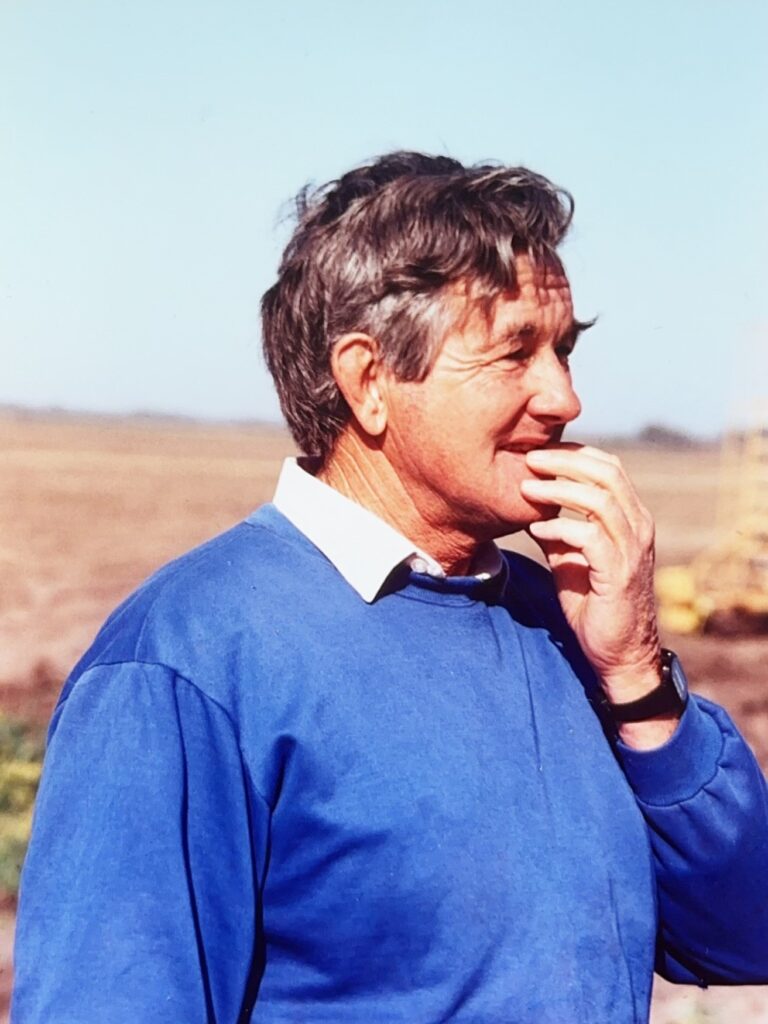
John Grellman has left a legacy with his vision and influence on the cotton industry.
***
John Porter Grellman was a highly successful visionary in the cotton industry, a mover and a shaker, yet a quiet achiever.
In 1960s Wee Waa is where it all began for John, involving himself in many aspects of the cotton industry with his main interest focussing on research and development.
John was involved in various industry boards and committees including as a Director of Namoi Cotton Co-operative and later as a Director of the Cotton Research and Development Corporation serving two three-year terms.
A member of the Australian Cotton Growers Research Association (ACGRA) from 1989 to 2000, John chaired the organisation during the period 1998 to 1999.
He also represented ACGRA on the Australian Cotton Industry (ACIC) for a number of years.
John was actively involved in establishing the Co-operative Research Centre (CRC) for sustainable cotton production which was later succeeded by the Cotton CRC, and he served on both boards.
John also enjoyed a strong relationship with the Commonwealth Scientific and Industrial Research Organisation (CSIRO) and was well known and respected by the research community.
He fought hard to ensure CSIRO had the funding and capital equipment to conduct local research and keep a strong research community in the Narrabri/Wee Waa area.
John played a large role in the direction of research in plant breeding, genetic engineering and also chaired a committee that reviewed all research being undertaken in cotton diseases.
John joined the board of Cotton Seed Distributors (CSD) in 1974 and was chairman from 1997 to 2008.
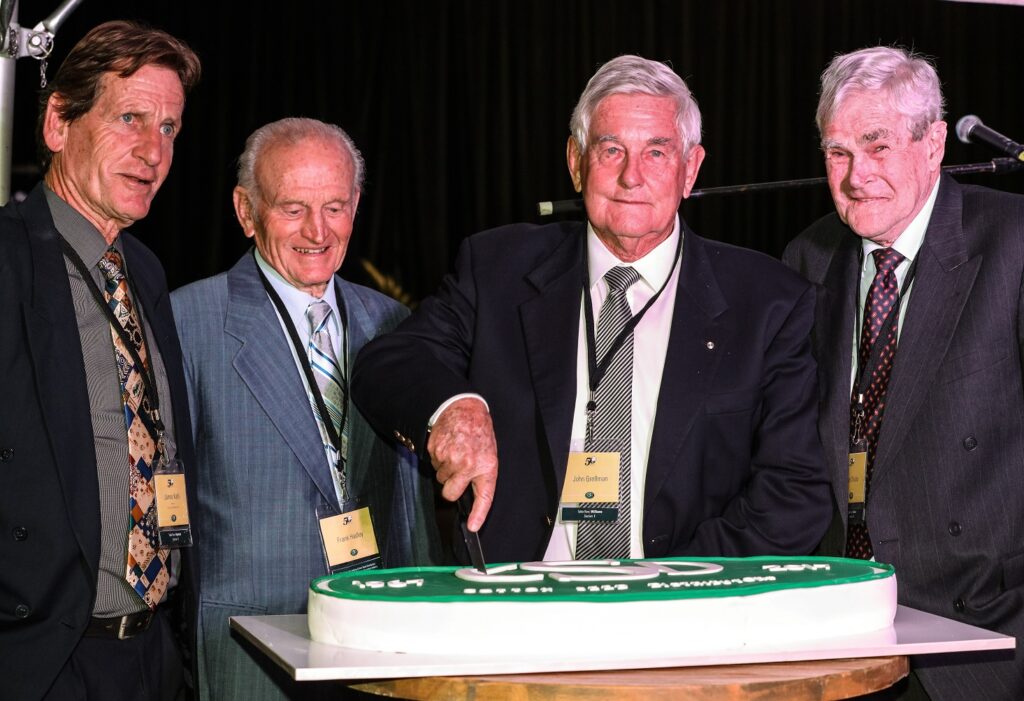
CSD 50th anniversary celebrations, 2017: James Kahl (chair from 2009-2022), inaugural chair Frank Hadley, former chair John Grellman, and former director Ralph Schulze.
During those 34 years John played a key role in shaping the future of the Australian Cotton Industry and in taking CSD to be recognised as a world class cotton seed business.
John took a very strong lead in formalising a long-term arrangement with CSIRO to ensure the security of cotton breeding for the Australian industry.
Over a 15-month period in 2006/07 a suite of agreements known as Cotton Breeding Australia (CBA), were negotiated with CSIRO and executed in July 2007.
His next sights were set on the possibility of CSD’s processing ability to produce planting seed for an expanding industry.
The production plant at the time was almost at capacity and if the industry was to continue to expand, CSD had to do something significant.
The project played out over a 10-year period and the current facility was proudly opened in 2018.
Never looking for nor expecting accolades, John was a true leader, a gentleman, and mentor, devoted to his family.
John has left a legacy with his vision for the cotton industry.
John is survived by his wife Jenny, sons and daughters-in-law David and Sharon, Tim and Louise (dec), Ian and Jo, Ben and Liz, and his adored twelve grandchildren, Nicholas, Jacqui, Charlie, Katherine, Alice, Emily, Jake, Isabella, Harry, Stanley, Olivia and Dan.
To order photos from this page click here

